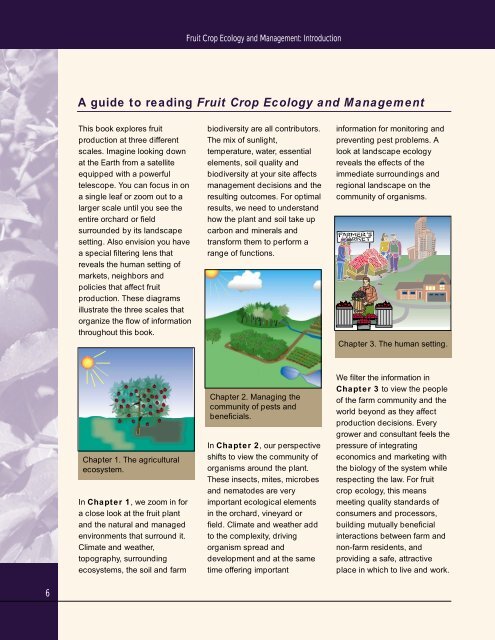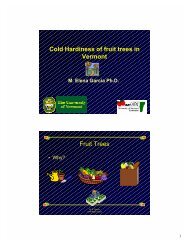Fruit Crop Ecology and Management - UVM Apple Orchard
Fruit Crop Ecology and Management - UVM Apple Orchard
Fruit Crop Ecology and Management - UVM Apple Orchard
Create successful ePaper yourself
Turn your PDF publications into a flip-book with our unique Google optimized e-Paper software.
6<br />
This book explores fruit<br />
production at three different<br />
scales. Imagine looking down<br />
at the Earth from a satellite<br />
equipped with a powerful<br />
telescope. You can focus in on<br />
a single leaf or zoom out to a<br />
larger scale until you see the<br />
entire orchard or field<br />
surrounded by its l<strong>and</strong>scape<br />
setting. Also envision you have<br />
a special filtering lens that<br />
reveals the human setting of<br />
markets, neighbors <strong>and</strong><br />
policies that affect fruit<br />
production. These diagrams<br />
illustrate the three scales that<br />
organize the flow of information<br />
throughout this book.<br />
In Chapter 1, we zoom in for<br />
a close look at the fruit plant<br />
<strong>and</strong> the natural <strong>and</strong> managed<br />
environments that surround it.<br />
Climate <strong>and</strong> weather,<br />
topography, surrounding<br />
ecosystems, the soil <strong>and</strong> farm<br />
<strong>Fruit</strong> <strong>Crop</strong> <strong>Ecology</strong> <strong>and</strong> <strong>Management</strong>: Introduction<br />
A guide to reading <strong>Fruit</strong> <strong>Crop</strong> <strong>Ecology</strong> <strong>and</strong> <strong>Management</strong><br />
Chapter 1. The agricultural<br />
ecosystem.<br />
biodiversity are all contributors.<br />
The mix of sunlight,<br />
temperature, water, essential<br />
elements, soil quality <strong>and</strong><br />
biodiversity at your site affects<br />
management decisions <strong>and</strong> the<br />
resulting outcomes. For optimal<br />
results, we need to underst<strong>and</strong><br />
how the plant <strong>and</strong> soil take up<br />
carbon <strong>and</strong> minerals <strong>and</strong><br />
transform them to perform a<br />
range of functions.<br />
Chapter 2. Managing the<br />
community of pests <strong>and</strong><br />
beneficials.<br />
In Chapter 2, our perspective<br />
shifts to view the community of<br />
organisms around the plant.<br />
These insects, mites, microbes<br />
<strong>and</strong> nematodes are very<br />
important ecological elements<br />
in the orchard, vineyard or<br />
field. Climate <strong>and</strong> weather add<br />
to the complexity, driving<br />
organism spread <strong>and</strong><br />
development <strong>and</strong> at the same<br />
time offering important<br />
information for monitoring <strong>and</strong><br />
preventing pest problems. A<br />
look at l<strong>and</strong>scape ecology<br />
reveals the effects of the<br />
immediate surroundings <strong>and</strong><br />
regional l<strong>and</strong>scape on the<br />
community of organisms.<br />
Chapter 3. The human setting.<br />
We filter the information in<br />
Chapter 3 to view the people<br />
of the farm community <strong>and</strong> the<br />
world beyond as they affect<br />
production decisions. Every<br />
grower <strong>and</strong> consultant feels the<br />
pressure of integrating<br />
economics <strong>and</strong> marketing with<br />
the biology of the system while<br />
respecting the law. For fruit<br />
crop ecology, this means<br />
meeting quality st<strong>and</strong>ards of<br />
consumers <strong>and</strong> processors,<br />
building mutually beneficial<br />
interactions between farm <strong>and</strong><br />
non-farm residents, <strong>and</strong><br />
providing a safe, attractive<br />
place in which to live <strong>and</strong> work.



